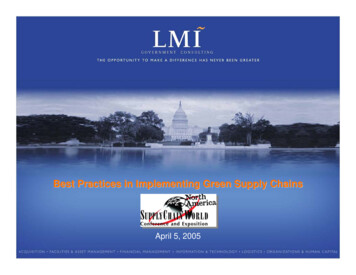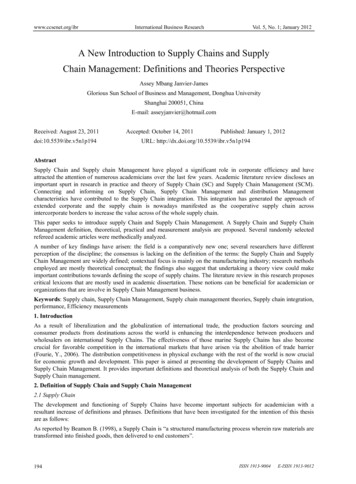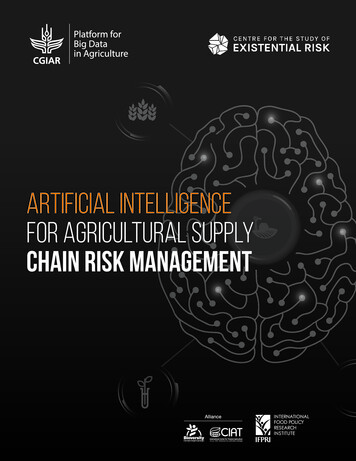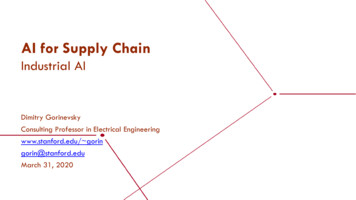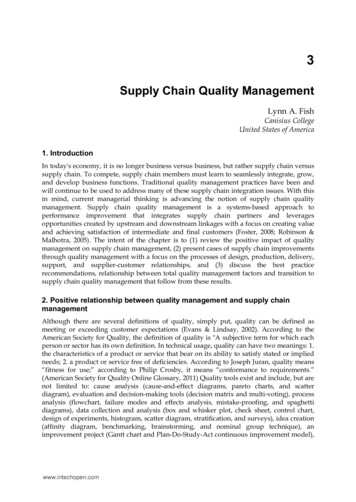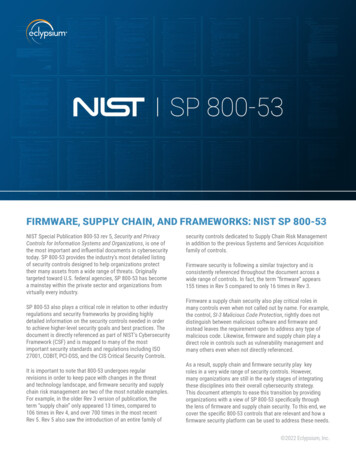
Transcription
FIRMWARE, SUPPLY CHAIN, AND FRAMEWORKS: NIST SP 800-53NIST Special Publication 800-53 rev 5, Security and PrivacyControls for Information Systems and Organizations, is one ofthe most important and influential documents in cybersecuritytoday. SP 800-53 provides the industry’s most detailed listingof security controls designed to help organizations protecttheir many assets from a wide range of threats. Originallytargeted toward U.S. federal agencies, SP 800-53 has becomea mainstay within the private sector and organizations fromvirtually every industry.SP 800-53 also plays a critical role in relation to other industryregulations and security frameworks by providing highlydetailed information on the security controls needed in orderto achieve higher-level security goals and best practices. Thedocument is directly referenced as part of NIST’s CybersecurityFramework (CSF) and is mapped to many of the mostimportant security standards and regulations including ISO27001, COBIT, PCI-DSS, and the CIS Critical Security Controls.It is important to note that 800-53 undergoes regularrevisions in order to keep pace with changes in the threatand technology landscape, and firmware security and supplychain risk management are two of the most notable examples.For example, in the older Rev 3 version of publication, theterm “supply chain” only appeared 13 times, compared to106 times in Rev 4, and over 700 times in the most recentRev 5. Rev 5 also saw the introduction of an entire family ofsecurity controls dedicated to Supply Chain Risk Managementin addition to the previous Systems and Services Acquisitionfamily of controls.Firmware security is following a similar trajectory and isconsistently referenced throughout the document across awide range of controls. In fact, the term “firmware” appears155 times in Rev 5 compared to only 16 times in Rev 3.Firmware a supply chain security also play critical roles inmany controls even when not called out by name. For example,the control, SI-3 Malicious Code Protection, rightly does notdistinguish between malicious software and firmware andinstead leaves the requirement open to address any type ofmalicious code. Likewise, firmware and supply chain play adirect role in controls such as vulnerability management andmany others even when not directly referenced.As a result, supply chain and firmware security play keyroles in a very wide range of security controls. However,many organizations are still in the early stages of integratingthese disciplines into their overall cybersecurity strategy.This document attempts to ease this transition by providingorganizations with a view of SP 800-53 specifically throughthe lens of firmware and supply chain security. To this end, wecover the specific 800-53 controls that are relevant and how afirmware security platform can be used to address these needs. 2022 Eclypsium, Inc.
FIRMWARE AND SUPPLY CHAIN INSP 800-53 CONTROLScustomized firmware and other device-level code that is tightlyintegrated with the hardware itself. These devices typicallycan’t support a traditional security agent, making it even harderfor security teams to find vulnerabilities and threats usingtraditional tools. Organizations should consider firmwaresecurity tools that can both identify vulnerabilities withinthese devices as well as verify the integrity of their firmware toidentify any potentially compromised devices.SP 800-53 is organized into 20 “families” of controls, whicheach contain a variety of underlying specific controls withdetailed guidance and discussion. For example, Access Control(AC) is a control family, which contains 25 controls such asAC-2 Account Management and AC-17 Remote Access.We have identified 40 controls across 12 control families inwhich firmware or supply chain security is either directly namedor plays a critical role in the context of the control. Appendix Aprovides a consolidated table of these controls along with briefexcerpts from SP 800-53 for reference. Additionally, for eachcontrol family, we have highlighted some of the most commonand high-impact firmware and supply chain security gaps foundin most organizations today, along with steps that securityteams can take to reduce their risk.CA - Assessment, Authorization, and MonitoringRelevant Controls: CA-2 Control Assessments C A-7 Continuous Monitoring C A-8 Penetration TestingCA-7 Continuous Monitoring states:AC - Access Control Continuous monitoring at the system level facilitatesongoing awareness of the system security and privacyposture to support organizational risk managementdecisions. The terms “continuous” and “ongoing”imply that organizations assess and monitor theircontrols and risks at a frequency sufficient to supportrisk-based decisions.Relevant Controls: AC-4 Information Flow Enforcement AC-6 Least PrivilegeFirmware is the most privileged code on virtually every device,and it is critical that organizations properly enforce leastprivilege for access to this code. However, firmware alsoplays a major and often overlooked role when it comes to theprotection of networking and security infrastructure. AC-4Information Flow Enforcement also calls out firmware, stating:While most security teams have automated tools for monitoringthe posture of their software and operating systems, theprotection of firmware often requires manual, time-consumingeffort from staff. This makes it almost impossible fororganizations to maintain appropriate visibility into the postureand integrity of their firmware. A firmware security platformautomates the analysis of firmware and can be configured toperform regularly scheduled scans of all firmware assets basedon the unique needs of the organization and its assets. Organizations also consider the trustworthiness offiltering and/or inspection mechanisms (i.e., hardware,firmware, and software components) that are critical toinformation flow enforcement.CM - Configuration ManagementNetwork devices and security tools such as firewalls andVPNs have themselves become some of the most heavilyattacked assets in any organization. Advanced threat actorsand ransomware groups have targeted vulnerabilities in thesedevices in order to gain initial access into an environment,which can then be used to spread further into the network andestablish ongoing persistence. Compromising network devicesalso means that attackers could potentially manipulate trafficand/or disable security inspection.Relevant Controls:Firmware security plays a particularly important role inprotecting these devices. Unlike laptops and servers that runstandard operating systems, network devices rely on highly2 CM-2 Baseline Configuration CM-3 Configuration Change Control C M-5 Access Restrictions for Change CM-6 Configuration Settings CM-7 Least Functionality CM-8 System Component Inventory CM-14 Signed Components 2022 Eclypsium, Inc.
Organizations often try to keep an inventory of their physicaldevices, yet this discipline typically does not extend down tothe underlying firmware. This is an important gap because it isthe firmware that defines the actual behavior of the hardwareas well as the many potential weaknesses that could allow anattacker to take control of the asset.task is handled by a physical chip called the Trusted PlatformModule (TPM) which generates, stores, and limits the use ofcryptographic keys. Vulnerabilities or attacks against the TPMcan allow attackers to compromise these keys and gain trustedaccess to any number of assets. A firmware security platformcan scan devices for vulnerabilities in the TPM that could putprivate keys at risk.It is critical that organizations have a complete understandingof the firmware in their devices and how it is configured inorder to properly manage their hardware attack surface and toverify the integrity of the supply chain. Devices rely on a varietyof low-level settings and protections that can leave a devicedefenseless if they aren’t configured properly. As SP 800-53notes, this extends down to the level of firmware in the physicalcomponents within a device.IR - Incident ResponseRelevant Controls:Adversaries increasingly attempt to introduce malicious codeinto firmware as a way to establish persistence and evadehigher-layer controls. The collection and analysis of unknownor malicious firmware during an incident can help reveal thetactics, goals, and identity of an adversary. Any changes tothe firmware integrity of devices involved in a security incidentshould be closely analyzed for threats. This may require thecollection and analysis of the firmware code running on thesystem or within system components. The incident handlingrequirements also extend to the supply chain with the standardcalling out the need to “Coordinate incident handling activitiesinvolving supply chain events with other organizations involvedin the supply chain.”Organizations should pay close attention to control, CM-2Baseline Configuration. A firmware security platform canautomatically monitor the baseline of all critical firmware ona system and can alert staff to any changes to the firmwarebaseline. Updates can be controlled and include the ability toroll back to previous known “good” versions.Likewise, firmware security tools can vastly simplify the workof building and maintaining an inventory of the firmware andcomponents within a system as defined by CM-8 SystemComponent Inventory. This can include components such asnetwork adapters, CPUs, memory, and storage drives, amongmany others.As with any analysis of malicious code, any analysis ofunknown firmware should be performed in a highly controlledmanner. Firmware-specific tools can be used to collectfirmware for forensic analysis either by internal staff or externalservice providers.CM-14 Signed Components calls out the need for organizationsto ensure that firmware updates are valid and properly signed.This is one of the most basic configuration settings of adevice or component, but without it, attackers can overwritevalid firmware with malicious code. A proper firmwaresecurity platform can proactively identify systems with suchmisconfigurations or missing protections. Additionally, they canmaintain a library of valid vendor-supplied firmware to verifythat only valid versions of the firmware are used or appliedduring updates.MA - MaintenanceRelevant Controls: MA-3 Maintenance ToolsMaintenance tools often require privileged access in order toproperly address the needs of a system, and this is particularly truewhen it comes to firmware. MA-3 Maintenance Tools notes thatsuch tools “can include hardware, software, and firmware items ”IA - Identification and AuthenticationRelevant Controls: IR-4 Incident Handling IA-5 Authenticator ManagementThere are several firmware-specific items that securityteams will want to consider as it pertains to managementtools. First, most laptops and servers contain built-inmechanisms to enable the out-of-band management of theIA-5 Authenticator Management calls out that private keys,naturally must remain private. And at a hardware level, this3 2022 Eclypsium, Inc.
device. In servers, this capability is provided by a dedicatedbaseboard management controller (BMC) which contains itsown firmware, memory, processor, networking, and power thatis completely independent of the host. Attackers have targetedthese critical components in order to take control of or damageservers. In laptops, similar functionality is provided by separatefirmware in the chipset such as the Intel Management Engine(ME) and Active Management Technology (AMT). Attackerssuch as the PLATINUM group have previously abused thesecapabilities to hide command-and-control from OS-levelsecurity controls.threat to be introduced into a product. Only by being able toindependently assess the risk of physical devices and theircomponents will an organization be able to ensure the integrityof their technology supply chain.It is important that security teams have the ability to monitorthese management features for vulnerabilities or any signsof compromise.RA-10 Threat Hunting introduces another area where firmwarewill play an important role. Adversaries specifically targetfirmware in order to persist on a system without detection andto evade traditional security controls. Threat hunters should beable to hunt for threats or any unexpected code or anomalousbehavior within the firmware of devices and their components.Specialized firmware security tools can close these gapsand ensure that risk and vulnerability assessments go allthe way to the firmware. This can include the detection offirmware vulnerabilities and misconfigurations and can useOS-independent mechanisms in order to truly verify the stateof the firmware.RA - Risk AssessmentRelevant Controls:SA - System and Services Acquisition RA-3 Risk Assessment RA-5 Vulnerability Monitoring and Scanning RA-9 Criticality Analysis RA-10 Threat HuntingRelevant Controls: SA-3 System Development Lifecycle SA-8 Security and Privacy Engineering Principles S A-10 Developer Configuration Management SA-10 Developer Configuration Management SA-11 Developer Testing and Evaluation SA-17 Developer Security and Privacy Architectureand Design SA-20 Custom Development of Critical Components SA-22 Unsupported System ComponentsVulnerability and risk management are some of the mostfundamental aspects of any organization’s security practice.However, the tools that are traditionally used to assesssoftware and operating systems lack the ability to reliablyanalyze firmware for weaknesses. This is due to the lowlevel nature of firmware, which often requires authenticatedscanning and specialized drivers in order to gain the neededlevel of visibility.The SA family is intrinsically connected to supply chain securityand calls out firmware across many of the included controls.This section lays out the importance of considering firmware atthe earliest stages of the technology lifecycle and establishesstandards both for internal developers as well as outsidetechnology vendors. Given that the vast majority of firmwareis delivered by outside vendors, many of the requirementsidentified in SA will apply to any selected vendors.There are also a wide range of low-level settings andprotections that must be properly configured in order to properlysecure a device. These risks are typically not detected bytraditional vulnerability management scanners, which insteadfocus on specific vulnerabilities or CVEs. Just as importantly,many vulnerability management tools will rely on informationprovided by the operating system. As recent attacks haveshown, an attacker with control over the firmware can reportfalse information in terms of the version of firmware that isinstalled and even prevent the system from being updated.However, security teams will need the appropriate tools bothto evaluate prospective vendors and to verify that selectedvendors are meeting their obligations in regard to developingand delivering secure firmware. A firmware security platformcan arm staff to independently verify the state of all firmwareboth during the technology selection process and whenverifying newly acquired assets.Unsurprisingly, virtually all of these aspects apply to supplychain risk management as well. Many of the controls in theRA family call out this need specifically. The complexity andconstantly changing nature of modern supply chains createsmany opportunities for a vulnerability, misconfiguration, or4 2022 Eclypsium, Inc.
SC - System and Communication Function SI-3 Malicious Code Protection S I-4 System Monitoring SI-7 Software, Firmware, and Information IntegrityRelevant Controls: SSC-3 Security Function Isolation SC-37 Out of Band Channels SC-39 Process Isolation SC-51 Hardware-Based ProtectionThe SI family of controls is one of the most important in regardto firmware security. SI-3 Malicious Code Protection calls outthe need for both signature and non-signature-based methodsfor detecting threats within code. Malicious code withinfirmware can have a very impact as it can allow attackers tocontrol and subvert all other aspects of the system. Threatssuch as firmware rootkits/bootkits, implants, and backdoorshave become increasingly common yet are often undetectableby traditional endpoint security and EDR tools that rely on theoperating system in order to analyze the underlying firmware.It is critical for organizations to employ tools that can detectany changes to the integrity of firmware, detect known firmwarethreats, and detect anomalous firmware behavior that couldindicate the presence of new or unknown threats.Firmware security is important to several SC controls, however,there are two important areas that are particularly significantand are often overlooked. SC-37 Out of Band Channels callsout the need to secure out-of-band channels, which can include“network paths physically separate from network paths usedfor operational traffic.”As discussed in the MA section, most servers and traditionalsystems such as workstations and laptops will includededicated hardware used for out-of-band management. Thebaseboard management controllers within servers provideout-of-band management of the device and include their ownindependent network interfaces, memory, processing, andpower. Any compromise to the BMC can allow an attacker totake control of the server or disable it entirely. More traditionallaptops often include out-of-band management capabilitiessuch as Intel’s AMT which runs on the dedicated ManagementEngine (ME) chip. While these components will share access tothe system’s network interface, they typically have a dedicatedconnection to the interface that is independent of the operatingsystem. These capabilities have been used by adversaries toestablish hidden command-and-control channels.SI-7 Software, Firmware, and Information Integrity goes intogreat detail regarding the need to verify and monitor theintegrity of firmware within an organization’s devices. Thisincludes not only monitoring the firmware itself, but also theintegrity of the boot process of the device. The control alsospecifies that organizations should: Employ centrally managed integrity verification tools. Implement cryptographic mechanisms to detectunauthorized changes to software, firmware, andinformation.Additionally, SC-51 Hardware-Based Protection calls outthe need to “ employ hardware-based, write-protect fororganization-defined system firmware components.” Thisrequirement is particularly important based on active threatsseen in the wild. Firmware threats such as TrickBoot,MosaicRegressor, and LoJax all target devices in which thesystem UEFI or BIOS firmware is not properly write-protected. Employ automated tools that provide notification upondiscovering discrepancies during integrity verification.A firmware security platform provides all of these keycapabilities, allowing organizations to verify the integrity offirmware, detect any changes, and automatically alert or otherautomated systems when problems are detected.A firmware security platform can easily address thesechallenges by scanning out-of-band management firmware forvulnerabilities and threats, while also proactively identifying anydevices that are not properly write-protecting their firmware.SR - Supply Chain Risk ManagementRelevant Controls:SI - System and Information IntegrityRelevant Controls: SI-2 Flaw Remediation5 SR-2 Supply Chain Risk Management Plan SR-3 Supply Chain Controls and Processes S R-4 Provenance SR-6 Supplier Assessment and Review SR-11 Component Authenticity 2022 Eclypsium, Inc.
Physical devices and equipment are some of the most commonand valuable assets within an organization, and these devicestypically rely on highly complex supply chains involving dozensof suppliers and subsuppliers across many countries of origin.Since virtually every physical system and component relieson firmware, every part of the supply chain can potentiallyintroduce vulnerable or malicious firmware components. Thepaper, Weak Links: Firmware Security for ICT Supply Chains(PDF) provides an in-depth analysis of how to integratefirmware into an organization’s SCRM strategy. Identify - Automate device discovery and provideongoing visibility into each device’s firmware, fromindividual firmware configurations to an inventory of thedozens of unique firmware components on every device.Quickly zero in on important components, attributes, orchanges that can impact your security posture. Verify - Proactively identify risks from outdated orvulnerable firmware or device misconfigurations. Verifythe integrity of all firmware and detect known andunknown firmware threats including rootkits, implants,and backdoors.The SR section specifically calls out the need to verify theauthenticity and provenance of all firmware and componentswithin a system as well as the ability to perform independenttesting of technology suppliers. Fortify - Remotely apply patches or updates toproactively mitigate device risks. Receive automatedalerts to any firmware integrity changes and driveautomated responses via integration with your existingIT and security tools with pre-built integrations withleading SIEMs, vulnerability management, and devicemanagement tools.A firmware security platform provides the critical abilityto independently verify and assess all critical firmwarecomponents within a device throughout all phases of thesupply chain. Prospective equipment can be evaluated toidentify supply chain problems during the selection process.Additionally, staff can quickly verify the authenticity of newlyacquired devices, while verifying that they have not beentampered with prior to delivery. Teams can likewise analyzethat updates are valid and monitor the behavior of firmwarefollowing an update to identify threats potentially introducedinto “approved” vendor updates.Built on industry-leading expertise and research, the Eclypsiumfirmware security platform makes it easy for organizations tointegrate firmware security into all phases of their security andrisk practices. With a single automated solution organizationscan identify and inventory their devices and firmware, find andprioritize vulnerabilities, detect firmware level threats, and takeaction to fortify their devices and mitigate risks. If you wouldlike to learn more, we recommend the following resources:CONCLUSIONS AND NEXT STEPSTo learn more about firmware security, we recommend theDefinitive Guide to Firmware Security.Firmware security plays a critical role throughout SP 800-53 rev5. This paper seeks to introduce some of the most importantexamples with a focus on the most common technical andprocedural gaps facing organizations today.To stay up to date with latest firmware security news, pleasesubscribe to the Below the Surface Threat ReportHowever, it is important to note that as threat actorscontinue to shift their focus to firmware, new security toolsare also available that can help security teams incorporateand automate firmware security into their existingpractices.“Firmware security”, for our purposes, means givingorganizations the ability to identify, verify and fortify firmwarewherever it exists in their infrastructure:To learn more about Eclypsium, please contact our team atinfo@eclypsium.com.6 2022 Eclypsium, Inc.
APPENDIX A - SUMMARY OF FIRMWARE CONTROLSFirmware related controls are designated with an asterisk (*).Access ControlAC-4 Information Flow EnforcementOrganizations also consider the trustworthiness of filtering and/or inspectionmechanisms (i.e., hardware, firmware, and software components) that are critical toinformation flow enforcement.AC-6 Least PrivilegeAuthorize access for organization-defined security functions (deployed in hardware,software, and firmware)Assessment, Authorization, and MonitoringCA-2 Control AssessmentsThe required skills include general knowledge of risk management concepts andapproaches as well as comprehensive knowledge of and experience with the hardware,software, and firmware system components implemented.CA-7 Continuous MonitoringThe terms “continuous” and “ongoing” imply that organizations assess and monitor theircontrols and risks at a frequency sufficient to support risk-based decisions. Automationsupports more frequent updates to hardware, software, and firmware inventories,authorization packages, and other system information.CA-8 Penetration TestingAuthorize access for organization-defined security functions (deployed in hardware,software, and firmware)Configuration ManagementCM-2 Baseline ConfigurationAutomated mechanisms that help organizations maintain consistent baselineconfigurations for systems include configuration management tools, hardware,software, firmware inventory tools, and network management tools.Retaining previous versions of baseline configurations to support rollback includehardware, software, firmware, configuration files, configuration records, and associateddocumentation.CM-3 Configuration Change ControlChanges to systems include modifications to hardware, software, or firmwarecomponents and configuration settings defined in CM-6.CM-5 Access Restrictions for ChangeChanges to the hardware, software, or firmware components of systems or theoperational procedures related to the system can potentially have significant effects onthe security of the systems or individuals’ privacy. Therefore, organizations permit onlyqualified and authorized individuals to access systems for purposes of initiating changes.7 2022 Eclypsium, Inc.
CM-6 Configuration SettingsIdentify, document, and approve any deviations from established configuration settingsCM-7 Least FunctionalityCode execution in protected environments applies to all sources of binary or machineexecutable code, including commercial software and firmware and open-source software.CM-8 System Component InventorySystem components are discrete, identifiable information technology assets that includehardware, software, and firmware.Detect the presence of unauthorized hardware, software, and firmware componentswithin the system CM-14 Signed ComponentsPrevent the installation of software and firmware components without verification thatthe component has been digitally signed using a certificate that is recognized andapproved by the organization.Contingency PlanningCP-9 System BackupSecurity-related information includes inventories of system hardware, software, andfirmware components.Identification and AuthenticationIA-5 Authenticator Management*(a) For public key-based authentication:(1) Enforce authorized access to the corresponding private key;Incident ResponseIR-4 Incident Handling*Analyze malicious code and/or other residual artifacts remaining in the system afterthe incident.Coordinate incident handling activities involving supply chain events with otherorganizations involved in the supply chain.MaintenanceMA-3 Maintenance ToolsApprove, control, and monitor the use of system maintenance tools;Maintenance tools can include hardware, software, and firmware items and may be preinstalled, brought in with maintenance personnel on media, cloud-based, or downloadedfrom a website.8 2022 Eclypsium, Inc.
Risk AssessmentRA-3 Risk Assessment*Conduct a risk assessment, including:1. Identifying threats to and vulnerabilities in the system;2. Determining the likelihood and magnitude of harm Assess supply chain risks associated with organization-defined systems, systemcomponents, and system services andUpdate the supply chain risk assessment when there are significant changes to therelevant supply chain, or when changes to the system, environments of operation, orother conditions may necessitate a change in the supply chain.RA-5 Vulnerability Monitoringand Scanning*a. Monitor and scan for vulnerabilities in the system and hosted applicationsEnumerating platforms, software flaws, and improper configurations;Measuring vulnerability impact; Employ vulnerability monitoring tools that include the capability to readily updatethe vulnerabilities to be scanned.RA-9 Criticality AnalysisThe functional decomposition includes the identification of organizational missionssupported by the system, decomposition into the specific functions to perform thosemissions, and traceability to the hardware, software, and firmware componentsthat implement those functions, including when the functions are shared by manycomponents within and external to the system.RA-10 Threat Hunting*Establish and maintain a cyber threat hunting capability to:1. Search for indicators of compromise in organizational systems; and2. Detect, track, and disrupt threats that evade existing controls;System and Services AcquisitionSA-3 System Development LifecycleAcquire, develop, and manage the system using organization-defined systemdevelopment life cycleTechnology refresh planning may encompass hardware, software, firmware, processes,personnel skill sets, suppliers, service providers, and facilities.SA-8 Security and PrivacyEngineering PrinciplesOrganizations can apply systems security and privacy engineering principles to newsystems under development or to systems undergoing upgrades given the current stateof hardware, software, and firmware components within those systems.9 2022 Eclypsium, Inc.
SA-10 Developer ConfigurationManagementRequire the developer of the system, system component, or system service to enableintegrity verification of software and firmware components.The integrity checking mechanisms can also address counterfeiting of software andfirmware components. Organizations verify the integrity of software and firmwarecomponents, for example, through secure one-way hashes provided by developers.Delivered software and firmware components also include any updates to suchcomponents.SA-11 Developer Testing andEvaluationRequire the developer of the system, system component, or system service toperform attack surface reviews. Attack surfaces include any a
and technology landscape, and firmware security and supply chain risk management are two of the most notable examples. For example, in the older Rev 3 version of publication, the . maintain a library of valid vendor-supplied firmware to verify that only valid versions of the firmware are used or applied during updates. IA - Identification and .





